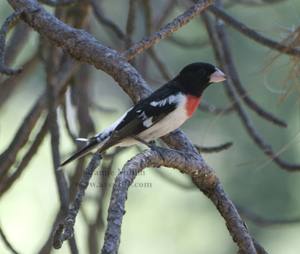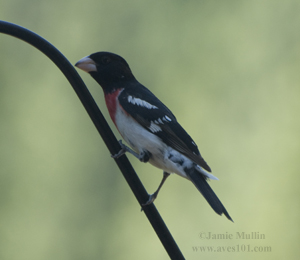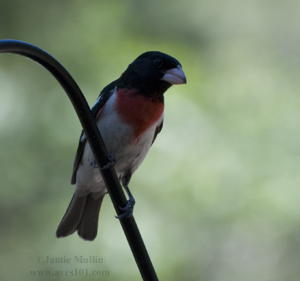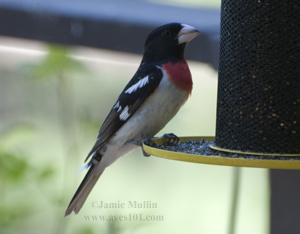Rose-breasted Grosbeak
Order: Passeriformes
Family: Cardinalidae
Genus: Pheucticus
Species: ludovicianus
**Audio Coming Soon**
Description
-
Length: 8"
-
Wing span: 12.5"
-
Weight: 1.6oz (45 grams)
-
Stocky medium sized songbird
-
Male distinctive with black hood, red chest, and white belly
-
Large, thick, pale, cone-shaped bill
-
White flash on wings in flight
-
Female Rose-breasted Grosbeaks are very similar in appearance to the Balck-headed Grosbeak females, sometimes making a correct ID impossible
Factoids:
- The male Rose-breasted Grosbeak, boldly patterned in black, white, and rose, is easily identified. The drab, striped female, however, is more of a challenge, resembling a large sparrow or finch. A common bird of forests and second growth, the grosbeak's song is like that of the robin, only as sung by an opera singer, being mellower and more sweetly melodic
- The Rose-breasted Grosbeak hybridizes with the Black-headed Grosbeak where their ranges overlap in the Great Plains. Hybrids can look like either parent species, or be intermediate in pattern, with various combinations of pink, orange, and black. Hybridization occurs most often where the densities of both species are low, and only rarely when densities are high
- In areas of overlap with the Black-headed Grosbeak, male Rose-breasted Grosbeaks responded equally to songs of both species. When presented with mounted birds, however, they attacked the Rose-breasted Grosbeak mount more. The males directed their attacks primarily at the white rump and flanks of the model, suggesting that the white rump is a more important stimulus than the red chest
- The nest of the Rose-breasted Grosbeak is so thinly constructed that eggs often can be seen from below through the nest
- The male Rose-breasted Grosbeak participates in incubation of the eggs, accounting for about 1/3 of the time during the day (the female incubates over night). Both sexes sing quietly to each other when they exchange places. The male will sing his normal song while near or actually on the nest
About the Photos: (click on link to see this information)
All photographs and audio clips are ©Jamie Mullin 2008
Sources: Cornell Lab of Ornithology & The Sibley Guide to Birds.
 |
|---|
 |
 |
 |
 |